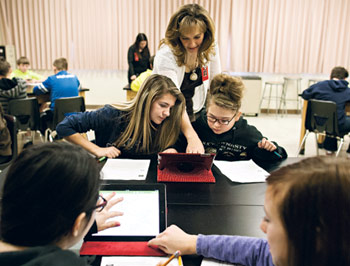Last week at Evergreen Junior High, Jean Crofts’ sixth grade social studies class spent the morning studying continents and oceans around the globe.
Instead of lecturing from the front of the room and instructing students to leaf through textbooks, Crofts bounced from table to table directing web traffic. Her 22 students were each engrossed in a device, whether it was an iPad, smartphone or other type of computer tablet. Instead of inspecting a traditional globe or atlas, they each poked and pinched the small screens, zooming in and out of interactive maps that displayed vibrant colors and geographical contours.
One student, using his finger like a wand, centered the screen on an elaborate satellite snapshot of the Himalayas. At a nearby table, a young girl clicked a button and suddenly watched the real-time climate pattern sweeping across Asia. Another classmate clicked an icon and India’s population density of 1.2 billion people dotted the screen.
Crofts’ class and four others in the Evergreen School District are the latest examples of the modern classroom in a new era of education.
The rapid evolution of technology and proliferation of devices like iPads and smartphones have changed the ways educators are nurturing young minds. School districts across the country are increasingly embracing technology in the classroom, including Evergreen, where a new initiative aims to utilize state-of-the-art resources while shaping a generation of frequent Internet users.
At Evergreen, educators have established a new “Bring Your Own Device” program that establishes designated days during the week when students can bring iPads and other devices to school. On those days, teachers and students work together on assignments and lessons that fully involve the Internet or online programs, such as Google Earth. The students are required to have parent approval, are under constant teacher supervision and must sign into the district’s safe and secure network, which bars them from accessing inappropriate content or websites such as Facebook. Along with common lesson plans, the BYOD classes also focus on teaching responsible social media etiquette, and raise awareness of the Internet’s pitfalls.
Five classes enrolled in the upstart BYOD program this year, two at the elementary level and three in junior high.
“As a teacher if you can hook them with something, you have to do it,” Crofts said.
The movement to expand new technology in the classroom is not without its doubters and critics, particularly as cyberbullying continues to come into view as a significant problem among teenagers.
But Evergreen Superintendent Laurie Barron believes educators have a responsibility – and opportunity – to create a positive, conducive learning environment within the modern world of technology.
“For the generation of students growing up now, to them iPhones, computers and iPads are not even technology, it’s their daily needs. It’s part of their daily lives,” said Barron.
“We cannot continue to believe that as educators we are the sole providers of knowledge for students anymore. That’s not what educators can be focused on anymore. We need to be facilitators of that knowledge. Students no longer need us to just provide information to them. They can go to Google and get it in an instant. What we’ve tried to do is use that tool and utilize it to our advantage.”
Barron took over as superintendent last fall after nearly 10 years as a middle school principal in a large district near Atlanta, Ga. She was named National Middle Level Principal of the Year in 2012 by MetLife and the National Association of Secondary School Principals, largely because of her innovative ideas for keeping students engaged and successful in the classroom. One of those innovations included implementing technology through devices like iPads that are becoming commonplace.
 |
|
Sierra Dunsmore, left, and Sydney Olson get help from sixth-grade teacher Jean Crofts as they work on a geography assignment during the Bring Your Own Device day at Evergreen Junior High on Thursday, January 9, 2014. – Greg Lindstrom | Flathead Beacon |
“Kids are immediately engaged in these devices. But then when they come into the educational world, those things are not allowed,” she said. “Why would we keep it out of the learning world? Research out there will show (devices do) improve student engagement, achievement, behavior. And it’s preparing kids for real life after school.”
In one of her first moves as superintendent, Barron proposed revising the district policy to establish the BYOD program. Although eyebrows were initially raised, Barron pitched the idea and laid out the benefits and safeguards.
“There’s no texting, no phone calls. It is strictly for educational purposes within that designated class period,” Barron said.
The board approved the initiative, and parents were notified and asked whether they wanted their students to be involved in the program. Students without a device can use one of the school’s, and Evergreen has started accepting old devices from residents who can receive a tax deduction by donating them for students.
After receiving parent approval, students in certain classes can now bring devices to school on BYOD days, but they must follow close guidelines, otherwise they will lose their privileges. As a result, Barron has seen few problems arise.
“What we’ve seen is that they are afraid of losing their privileges, so we are not having discipline problems,” Barron said. “They are terrified because we told them if they play with it at lunch or text friends in the hall, they lose their privilege.”
Although Barron acknowledged the threat of cyberbullying does exist more and more in today’s cellphone society, she hopes that students at Evergreen are realizing the benefits that devices can have academically, and that those ideals are extending beyond the classroom.
“While teaching some appropriate use, we hope that’s transporting to home and that kids become more responsible with their devices,” she said.